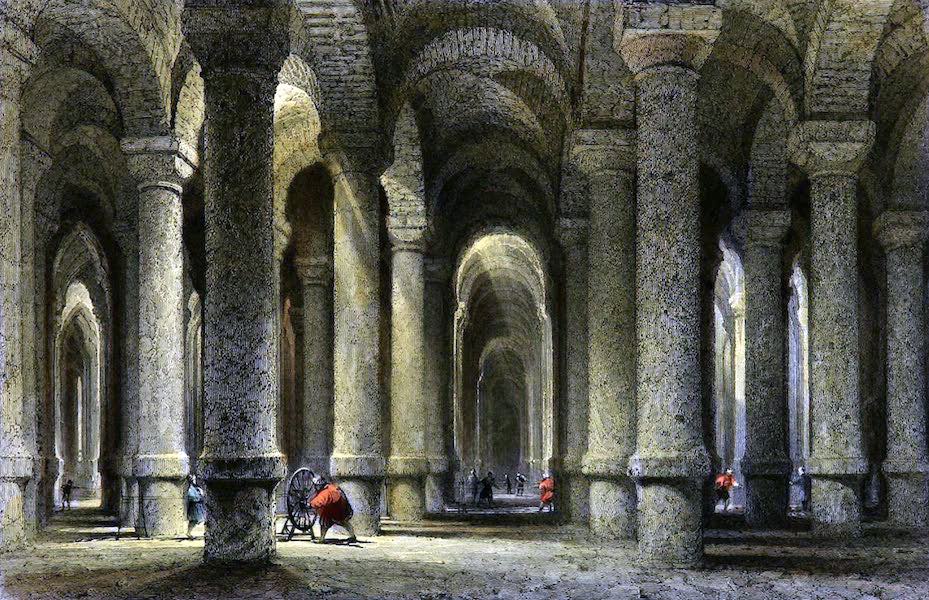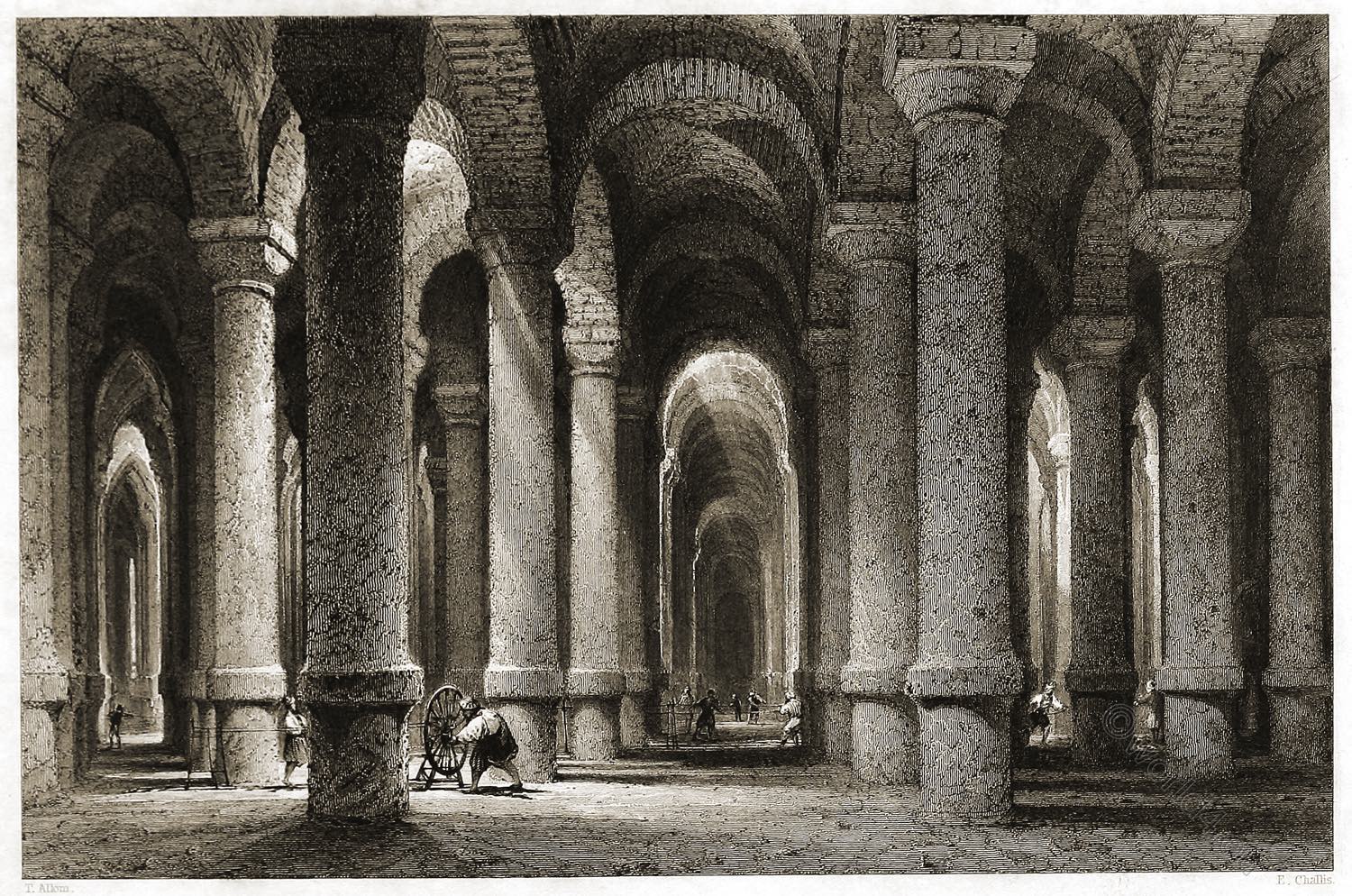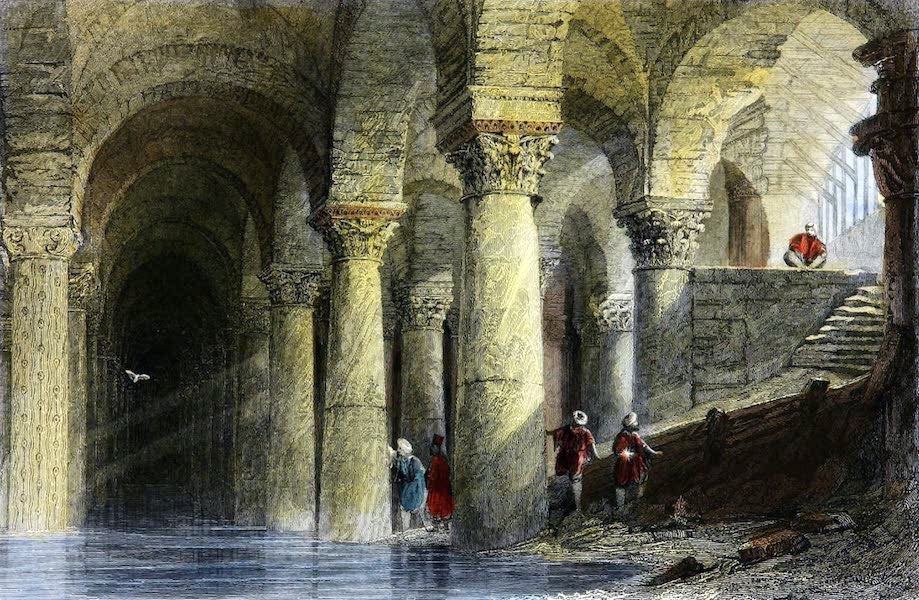
Constantinople and its environs.
THE CISTERN OF BIN-BIR-DEREK. CALLED, THE THOUSAND AND ONE PILLARS.
The shores of the Black Sea, among the forest-covered ramifications of the great Balkan, is a region of constant showers and copious streams, filling, naturally, small reservoirs in the mountains. Wherever such rills poured down, and became confluent, they were stopped by a mound thrown across the valley, and in this way formed into various triangular lakes at an elevation above the summit-level of the city.
These reservoirs, called Hydralea, were highly prized by the Greek emperors. The embankments were faced with marble, adorned with sculpture, and dignified by the name of the sovereign who formed them. They were deemed so sacred, and of such vital importance to the city, that severe edicts were enacted to preserve them; some regulating the planting of trees, some the abstraction of water, and one exacting a penalty of an ounce of gold for every ounce of the crystal fluid. As water is more precious to the Turks than it was to the Greeks, they watch these reservoirs with even more anxiety and vigilant precaution. They call them Bendts, and have increased the number left by the Roman emperors. One of the largest and most magnificent is called Valadi Bendt, from the mother of the present sovereign, at whose expense it was erected.
From these reservoirs the water is conducted by pipes, formed of cylindrical tiles jointed together, and so conveyed to the city a distance of about fifteen miles. The ravines, that break the intervening country, are crossed by aqueducts, some of vast dimensions, striding the valleys, and towering above the forests. They are whitewashed at stated intervals, and form striking objects in distant prospects, strongly relieved by the dark woods above which they rise. One of them terminates the view up the great valley of Buyukdere, and seems, to mariners passing on the Bosphorus, like the battle- ments of a large city, on the distant horizon.
Besides these, there are others of more peculiar structure. They are insulated hydraulic pillars, called Souterrais, standing in long rows, like slender square castles or watch-towers. The water ascends one side of each, is received into a small square reservoir on the summit, and from thence descends the other. It climbs the next in a similar manner; and by this contrivance, for which the Turks are indebted to the Arabs, the vast expense of aqueducts is saved, and the water conveyed by many channels over various hills and valleys, in continued and never-ceasing streams, to its magnificent reservoirs in the city.
When the water arrived here, it had the same irregularity of surface to oppose, its seven hills to surmount, and seven valleys between them to cross. This was effected by a second series of aqueducts, which are described by the Byzantine historians with all the inflated language of astonishment. They are represented as “subterranean rivers” conducted through the air over the city, while the people gaze in wonder from below. “Of these, but one remains to attest what they were. This is the aqueduct of Valens, stretching from hill to hill, and seen in almost every direction. Its erection was the completion of a singular prophecy: On the ramparts of Chalcedon was found a stone with an occult inscription, implying that “the walls of the city should bring water to Constantinople.” To extend these walls across the sea, seemed altogether an impossibility, and the oracular announcement was despised. But Chalcedon having incurred the resentment of the emperor, its walls were pulled down, the stones conveyed to Constantinople for building, and, among other erections formed of them, was the aqueduct of Valens, thereby accomplishing the oracle.

By means of this aqueduct, the waters were deposited in various, cisterns; some open, and some covered, so that the whole city was excavated into exposed or subterranean reservoirs. One great inconvenience attended those that were exposed. The city and vicinity of Constantinople abounded in storks; they were supposed to convey serpents, and drop them in the water, by which it was poisoned, and rendered fatal to those who drank it. The celebrated impostor Apollonius of Tyana, who was reputed to work such powerful miracles, was applied to, by the reigning emperor, for a remedy. By his directions, a pillar called Pelargonium was erected, on the summit of which were three storks fronting each other ; and by this talisman the kindred birds were immediately expelled the city, and the salubrity of the waters restored. To commemorate the event, the following epigram was inscribed on the base of the pillar.
On sculptur'd column stands the mystic charm,
And guards the fainting citizens from harm.
Far fly the storks, to seek the distant wood;
And snakes no longer taint the wholesome flood.
These cisterns were afterwards filled up with earth, and are now converted into gardens, where the storks, no longer the cause of evil, are invited to return. The Turks evince a particular attachment for them, and erect frame-work like cradles on the tops of their houses, which the birds inhabit and breed in.
Of the covered cisterns, but two remain. One is called Yèrè-Batan-Serai, or the “Subterranean palace,” and is still filled with water. It resembles a vast subterranean lake, out of which issue rows of 336 marble pillars, of various orders of architecture, supporting an arched roof. The memory of this magnificent watering-palace was altogether lost the streets passed over it, and the houses above were supplied from it with water, while the inhabitants knew not whence it came. After it had remained unknown to the Turks since the capture of Constantinople, it was discovered by Gillius more than three hundred years ago.
A second time it fell into oblivion among this incurious people, till it was searched for, and again found a few years since. It was formerly in total darkness, but part of the wall has fallen down, and sufficient light is admitted to examine it. A boat, or raft, is moored to one of the pillars, in which strangers are permitted to embark, and explore its dim recesses; and marvellous stories are told by the Turks of the fatal end of those bold adventurers.
The second cistern is no longer employed as a reservoir for water. It lies beneath an open area in the vicinity of the Atmeidan, and is converted into a silk manufactory by a number of industrious Jews and Armenians. The Turks have named this subterranean palace Bin-bir-derek, in allusion to its supposed original number of columns, 1001, although 212 are all that can now be distinguished. Each column is said to consist of three shafts with their respective capitals, but the lowest is, at present, buried beneath the material of the flooring. The whole enclosed area occupies 20,000 square feet, and is capable of containing 1,237,000 cubic feet of water, a quantity sufficient to supply the population of Constantinople for fifteen days.
The pillars of this cistern are distinguished by monograms deeply cut on the shafts and capitals, like hieroglyphics on an Egyptian obelisk, and so obscure as equally to puzzle the learned. One of them consists of the Greek initials for Euge philoxene, “Hail, thou strangers’ friend.” This cistern, under the Greek empire, was decreed to be public for the use of all strangers, and was therefore called philoxenos.
Source: Constantinople and the scenery of the seven churches of Asia Minor illustrated. In a Series of drawings from nature by Thomas Allom (1804-1872). With an historical account of Constantinople, and descriptions of the plates by the Rev. Robert Walsh LL.D. (1772-1852). Fisher, Son, & Co, 1839. Newgate St., London; & Quai de L’Ecole, Paris.
Related
Discover more from World4 Costume Culture History
Subscribe to get the latest posts sent to your email.






